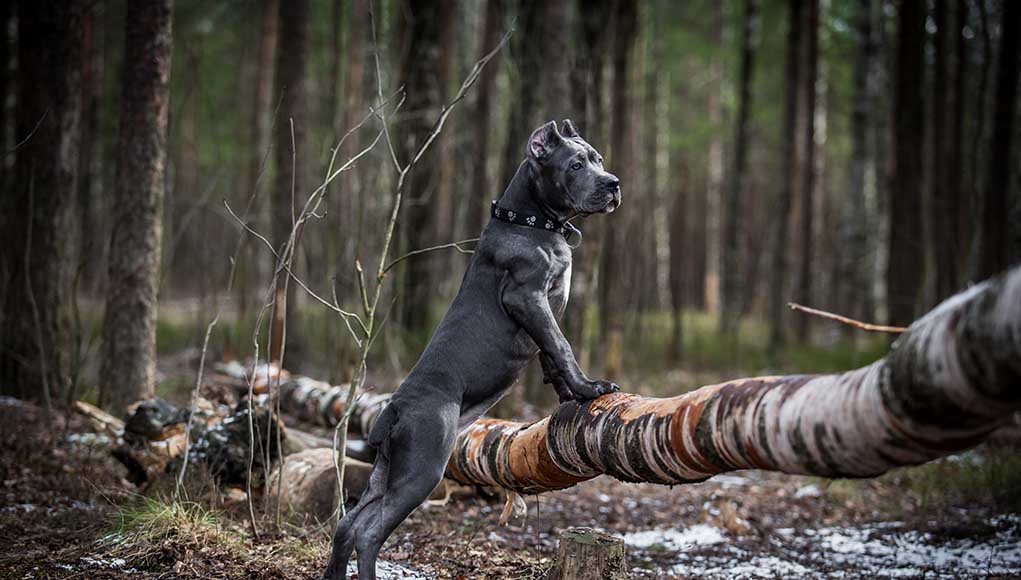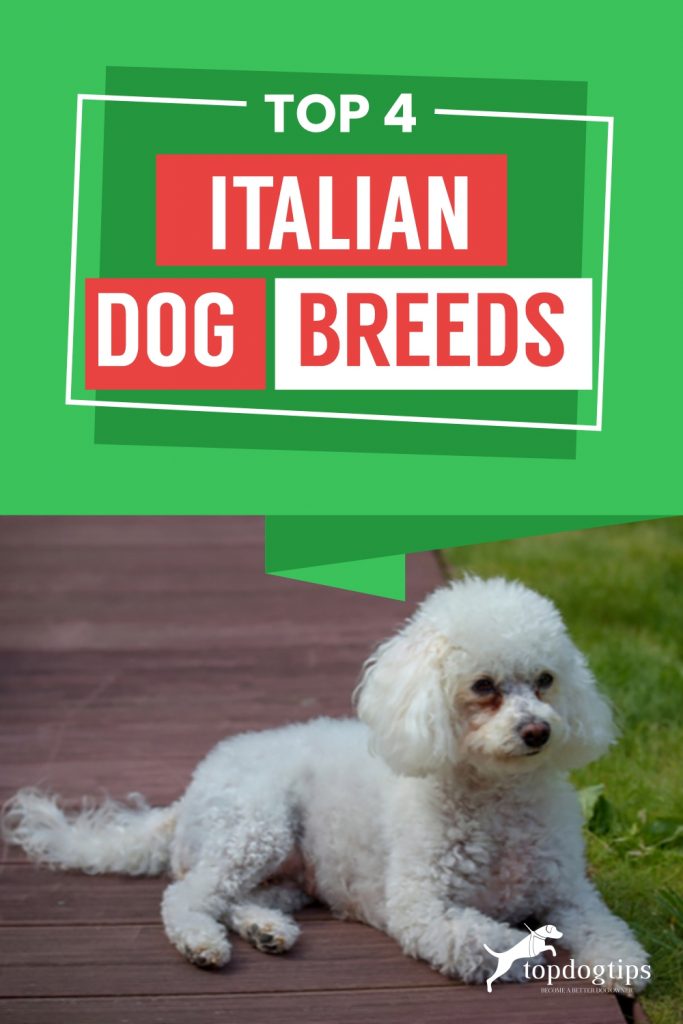Italy is well loved for their fashion sense, food and wine. But perhaps what is not so apparent is their assortment of unique Italian dog breeds. Dogs like the Bolognese, Cane Corso, Spinone Italiano and the Neapolitan Mastiff all originate from Italy.
Continue reading to learn more about each of these fascinating breeds. The Italian breeds are diverse, come with a variety of personalities, sizes and features.
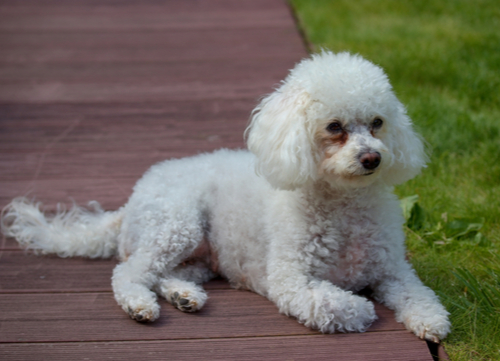
Bolognese
According to the history books, the Bolognese is a distant relative of the Bichon Frise.
Since the Bichon Frise is part Maltese, you could argue that the Bolognese has some mixed blood. Contrary to popular belief, they are not named after bolognese sauce.
The breed was named after the northern Italian city, Bologna, which is where it was first bred.
These canines have been around since the 11th century and they were kept as companion dogs by Italian nobility.
Behavior and Temperament
The Bolognese is a pleasant breed, they love being in the home and feeling as if they are a true part of the family.
They are known to be affectionate, fun-loving, loyal, and intelligent. They enjoy being around people and thrive on human contact.
The Bolognese is the perfect dog for anyone who is at home all the time such as housewives or a retiree because they need constant attention and don’t do well on their own.
Even leaving them alone for short periods of time can cause separation anxiety which can manifest in destructive behaviors.
Small dogs are renowned for their unruly attitudes; but not this breed, the Bolognese has a calm and gentle manner.
Although they are standoffish with people they don’t know, they are not aggressive. When Bolognese doesn’t feel comfortable around someone, they just stay away from them.
The Bolognese is highly intelligent and requires a lot of mental stimulation for them to become well-rounded characters who are truly happy.
Because this Italian breed gets along well with people, they are easy to train and are great dogs for first-time owners.
The Bolognese doesn’t need a lot of exercises which is a good reason they are well suited to elderly people.
A 30-minute walk twice a day will do. Although they love being around humans, this breed has a strong prey drive and they are quick to give chase to anything that moves.
You will need to start the training process with your Bolognese dog as soon as you get him.
As with most dogs, if you put off training them for too long, they get set in their ways and you will find it difficult to train them.
Grooming
If you are not looking for a high-maintenance dog, the Bolognese is not for you. They don’t shed, but you will need to brush their coats daily to prevent matting and tangling.
The Bolognese white, long curly locks are prone to getting dirt, dust, and mud trapped in them. There is no hard and fast rule as to how often you should bathe your dog, do so when they look or smell like a bath is needed.
Additionally, use a whitening shampoo to maintain the bright whiteness of their coat. You should take them to a professional groomer at least twice a year, making it easier to look after their coats throughout the year.
Brushing their teeth once a day and snipping their nails once or twice per month is recommended.
Additional Information
- Lifespan: 12 – 16 years
- Colors: White
- Weight: 8 – 14 lbs
- Height: 9 – 12 inches
- Hypoallergenic: Yes
Fun Fact: There are several famous paintings that feature the Bolognese dog including the Duke of Mantua, and the Titan portrait of Federico Gonzaga.
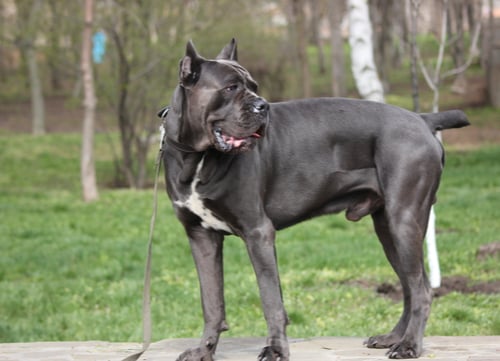
Cane Corso
Developed in Italy, this Mastiff–type breed is a distant relative of Roman war dogs. They were bred to watch over the property, hunt game, and work the farm.
Their work involved gathering together cattle or pigs so that farmers could take them to the market.
The breed became less popular as technology developed, and machines began to take over the farming process.
Behavior and Temperament
The Cane Corso is a determined Italian breed. They like a good challenge and to participate in new tasks.
However, their determination not to give up can manifest as stubbornness when they want to get their own way. They need a consistent and confident owner with a firm hand who will prevent the dog from going off and doing its own thing.
The Corso makes the perfect family dog, when they have settled into the company of its owners, they are loving, affectionate, and calm.
However, they can get aggressive around strangers.
The Corso is extremely intelligent, and they are known to make unnecessary demands. Your pet will push boundaries to see how far they can go.
Without firm leadership from their owner, they are known to dominate a household.
Grooming
This breeds coat is short, but it is very thick and coarse. The Cane Corso is a double-coated breed and the undercoat sheds year-round.
It will need weekly brushing and currying to get rid of dead hair and experts advise that you bathe the dog as needed.
Their nails grow quickly and will need trimming every two to three weeks. Clean their ears at the same time as brushing the fur and brush their teeth daily.
Additional Information
- Lifespan: 9 – 12 years
- Colors: Red, black brindle, grey, fawn, chestnut brindle, black
- Weight: Proportionate to height
- Hypoallergenic: No
Fun Fact: The Cane Corso has been around for a long time, but it nearly went extinct during World War II.
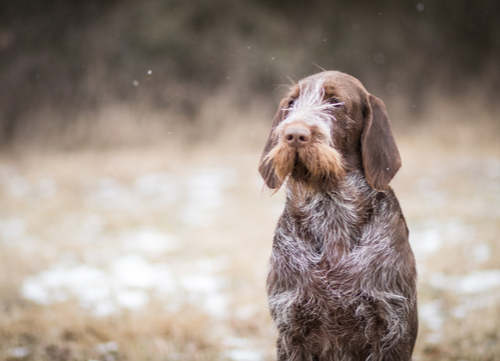
Spinone Italiano
The Spinone Italiano was originally bred to hunt waterfowl; the breed is well-loved in the United States for its loving and loyal nature.
The Spinone Italiano has been recognized as an official breed by kennel clubs worldwide.
Although they make excellent hunters, the Spinone is a dedicated family pet. They are committed to their owners and they enjoy spending time with them.
The breed is skilled in all aspects of hunting including flushing, retrieving, setting, and pointing.
These canines are friendly to both humans and dogs, but they don’t like small animals. When they see them, they go into attack mode and chase.
When in the field, the Spinone will work their paws to the bone; but at home, they are chilled and relaxed. They are often described as patient and they have a deep love for children.
Behavior and Temperament
Even though the Spinone Italiano is a sporting breed, they don’t need as much exercise as other dogs.
Taking them out hiking or for a walk is great, but you won’t need to do this every day. A large yard with a secured fence will give your dog enough space to play when he wants to.
Being a well-loved part of the family is equally as important as getting plenty of exercise with the Spinone.
Additionally, they are not kennel dogs, they must live in the home with their owners.
When it comes to training the Spinone, you will need to play a bartering game with them. When you give the jump command to the majority of Italian dog breeds, they want to know “how high.”
But the Spinone wants to know “why”. Sometimes they are just not in the mood for training, and they will let you know this.
They are intelligent and will challenge you. If they find training too difficult or harsh, they will refuse to continue.
It is also important to mention that if you want your Spinone to hunt, you won't need to tell them where or what to hunt.
They know exactly what they are doing, and they will find food for you. The Spinone wants their owners to trust them.
Grooming
Their coats are thick, wiry, and of medium length; the breed is not considered high maintenance. They need brushing a few times a week, and when necessary, run your fingers through their hair to get any knots out.
Their long beards get wet when they are drinking, you will need to maintain this because the dampness can cause an unpleasant mildew-like smell.
Clean out your dog’s ears at least once a week, and don’t bathe them more than once a month. Brush their teeth once a day and clip their nails twice a month.
Additional Information
- Lifespan: 10 – 12 years
- Colors: Orange and white, orange roan, brown roan, white
- Weight: 34 – 39 kg
- Hypoallergenic: No
Fun Fact: The Spinone Italiano has been around since 200 A.D. making the breed one of the world's oldest hunting dogs.
Neapolitan Mastiff
Mastiffs were first bred in Tibet more than 5,000 years ago. It became a Neapolitan Mastiff in the southern Italian town of Naples, which is where it gets its name.
Italian breeders purposely bred the dog with a heavy size and stature to protect them in case they were attacked by their enemies.
At the same time, they wanted a dog who was loving and loyal when part of a family.
Behavior and Temperament
Despite their laid-back nature, the Neapolitan Mastiff is always aware and alert. They guard rather than attack and they are extremely firm and sturdy in their stance.
Your dog won’t let anyone onto your property if you are not home, and most people who are confronted with them won’t bother trying to put up a fight as their size is intimidating.
However, once you have introduced them to a guest, they will accept that person as a family friend, but they won’t give them the same level of affection.
Neo’s love their owners and they make great family pets, but they are also very stubborn, and if they are not trained properly from an early age, you are going to have problems getting them to submit.
The Neo loves being at home, you won’t catch them dashing out the door trying to escape. However, it is advised that a fence is placed around the yard so that they are aware of the boundaries of the property.
The Neapolitan Mastiff is not suited for cold or extreme weather because their coats are not long enough.
It is advised that you get your dog a jacket during the winter months. During the summer months, you will need to apply sunscreen to the nose, ears, and sensitive areas.
If you are not willing to train a Neapolitan Mastiff puppy, but you desire to have one as a pet, you can purchase them as an adult from a rescue group. They will have been trained and socialized already.
Grooming
The Neo sheds no more or no less than the average dog. You will need to brush their coat weekly with a hound glove or a bristle brush.
Bath them as needed, trim their nails once or twice a month depending on how long they grow. Brush your dog’s teeth daily to prevent bad breath and gum disease.
Additional Information
- Lifespan: 7 – 9 years
- Colors: Tawny, brindle, black
- Hypoallergenic: No
Fun Fact: The Neapolitan Mastiff has very unique physical features including a lumbering gait, loose skin, and wrinkles.
They are all due to generations of selective breeding with minimal influence from other Italian dog breeds.
Italian Dog Breeds Final Thought
Regardless of the dog, you wish to purchase, finding a reputable breeder is essential.
Before any transactions take place, make sure you have conducted the proper investigations.
The best way to determine whether a breeder is reputable is to check if they are registered with a legal body such as the American Kennel Club.
Additionally, it is advised that you seek out pet owners who have used them in the past.


